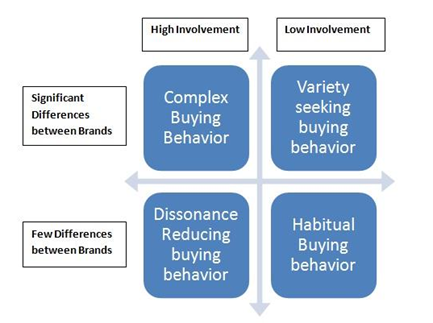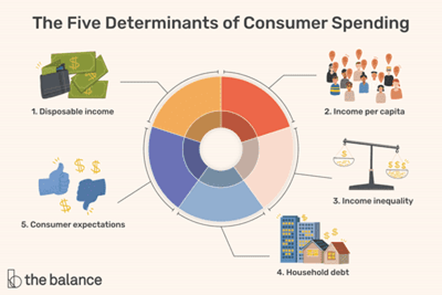
The Definitive Guide to Understanding Consumer Behavior in Your Industry
Consumers spend money every day. Whether it is grabbing their morning coffee, filling up their car’s gas tanks, or picking up weekly groceries, they are always buying something. Many of these purchases have become second nature, and better understanding this consumer behavior can help marketers anticipate everyday purchasing patterns.
Key Takeaways
- Understanding consumer behavior can help marketing teams identify what factors most influence purchasing patterns.
- Marketing teams often break down customer behavior types into four categories: complex buying, dissonance-reducing, habitual buying, and variety-seeking.
- Understanding a consumer’s personal preferences might be crucial to influencing their purchase decisions.
- A potential customer’s capacity to buy non-essential items could be the determining factor in purchasing decisions.
What is Consumer Behavior?
Consumer behavior refers to all factors that may impact how a consumer goes about researching products and why they choose one over its alternatives. It utilizes concepts from several scientific areas of study, including economics and psychology.
Why is Understanding Consumer Behavior Important?
Understanding consumer behavior can help marketing teams better understand the factors that influence customer purchasing choices.
By learning more about how potential customers choose products, marketers can identify items that are in high demand and those that are outdated.
Understanding purchasing behaviors might also help marketing teams choose new and creative ways to present products to consumers. Differing marketing strategies may result in differing impressions on customers, which in turn can impact buying decisions.
To learn more about these behaviors, marketing teams might consider running analyses to identify certain consumer tendencies and their resulting buying trends. Those data points could include:
- Consumers’ tendencies when researching and shopping for products.
- How customer pain points can affect product research.
- What potential customers think about alternative brands (i.e., your competitors).
- What factors push consumers toward one product instead of another.
- What external factors – such as family and social media – impact purchasing patterns.
Marketers then typically aggregate those influential factors into three main categories:
- Psychological factors: A potential customer’s personality and attitude may affect their interpretation and response to a given marketing campaign.
- Personal factors: Every individual is different and with that comes specific interests and varying opinions. A consumers’ demographics, including gender, age, and geographic location, might influence those factors.
- Social factors: Along with family and social media (as mentioned in the prior section), factors such as education and income levels can also influence purchasing behaviors.
The Four Consumer Behavior Types and What Affects Them
Understanding consumer behavior may also require a solid understanding of behavior types and what influences – both internal and external – impact those behaviors.
The Consumer Behavior Types
Most marketing experts view the following as the four generally accepted types of consumer behavior:
- Complex Buying Behavior. You might observe this behavior in consumers when they are considering an expensive and infrequently purchased item. They are directly and significantly involved in the buying process, and they tend to conduct thorough research before making such a large financial commitment.
- Dissonance-Reducing Behavior. Like the complex buying behavior, consumers are highly involved in the buying process. However, they have difficulties making distinctions between competing brands. “Dissonance” refers to a situation where the consumer is concerned that they will make the wrong brand choice.
- Habitual Buying Behavior. In this case, the consumer has minimal involvement in the product and no real brand loyalty. Instead, they make purchases habitually based on familiar buying patterns.
- Variety-Seeking Behavior. Consumers sometimes look to purchase a different brand not because the initial purchase was unsatisfactory, but because they prefer variety.

What Affects Consumer Behavior?
While many factors can affect and shape a consumer’s purchasing behavior, the four common ones are as follows:
- Economic Conditions. This can often affect the decisions to make large purchases, such as a house or a new car. If the economy is strong, consumers might be more likely to spend money, regardless of their financial situation.
Conversely, if all signs point to a weakening economy, customers may be inclined to minimize spending until markets recover
2. Marketing Campaigns. When you execute marketing campaigns properly, they may significantly influence consumer purchasing patterns. They can even go so far as convincing customers to change brands outright or choose pricier alternatives.
Marketers might also use campaigns to send periodic reminders to customers about products they purchase regularly but are not always at the mind’s forefront.
Lastly, a well-crafted marketing campaign could encourage people to make impulse purchases that were not a previous consideration
3. Personal Preferences. In the end, the quality and effectiveness of a marketing strategy might only carry a product so far. Instead, consumer preferences could have a larger impact on decision-making.
Personal views – including likes, dislikes, morals stances, and specific priorities – could weigh more heavily than any marketing scheme. If a consumer feels very strongly one way or another about a product, that could be the determining factor.
- Purchasing Power. Of course, how much a consumer can spend at any given time could also impact purchasing behaviors. Except for extremely affluent buyers, people often pick and choose what they buy, starting with the bare necessities.
The fact that you offer a high-quality product and market it effectively may not matter in some circumstances. If a consumer is tight on funds with very little disposable income or substantial debt, they may have to pass unless you are providing a necessity.
Separating customers into buckets based on their purchasing power might help your marketing team fine-tune its target customer base by weeding out those who likely cannot afford the product.

Understanding Customer Behavior May Be Crucial to Your Marketing Efforts
Understanding consumer behavior can be difficult. It often requires identifying and analyzing several factors that go into a person’s purchasing decisions. However, you may find that it is crucial to influence buying patterns and convince customers to choose your products over those of a competing brand.
At Boom Communications, we have a team of experienced marketing professionals that can help you identify these consumer behaviors to better anticipate future purchasing patterns.
Contact us today to discuss how we can help you maximize your marketing efforts.
